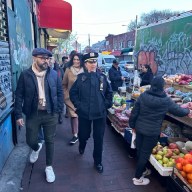By Alexander Dworkowitz
Every week, dozens of mentally retarded men and women travel to nursing homes throughout the borough.
With homemade food tucked under their arms, the disabled come to help feed the elderly, chat and sometimes even sing.
The men and women serve in the Give Back Program of the Association for the Advancement of Blind and Retarded, a College Point non-profit organization.
The program, which also includes activities such as volunteering at libraries, is designed to give AABR’s “consumers” independence and confidence.
“We don’t want people in the community to view people with disabilities as helpless and hopeless,” said Kathryn Flood, an assistant executive director of AABR. “Every consumer’s life has value, true value.”
The program is one of many offered by one of the borough’s larger service organizations.
In 1956, a group of parents met to discuss how to take care of their disabled children.
“They were trying to find services for their blind and retarded children,” explained Jane Carnacchio, an assistant executive director. “Their choice was an institution or nothing else.”
In the basement of a Queens library branch the group founded a small program known as AABR. A decade later, the program evolved into a full-time school.
In 1973, AABR opened a residence for mentally retarded adults, the first of its kind in Queens.
Today, the organization operates 18 homes across the city, 10 of which are in Queens. On average, eight people live in each home.
The AABR’s schools in St. Albans and Jamaica are attended by residents of the association’s homes. Classes at the schools range from woodshop to music to job training.
A third school, the New York Child Learning Institute in College Point, treats children with autism.
The organization also provides case management at the homes of 220 mentally retarded children and adults throughout the borough.
In addition to the AABR’s growth, the nature of the organization has changed over the years. While the organization originally catered to children who were both blind and retarded, most who use its services today are not visually impaired, and the majority are adults.
When AABR started in 1956, it was one of the first programs of its kind. Although private agencies for the mentally retarded have exploded since, AABR still stands out, its directors said.
“What makes AABR unique is the culture of the agency,” Flood said.
That culture, its directors said, is based on an extremely dedicated staff.
While turnover in the field is high, many of the staff have stayed with AABR for a long time, Carnacchio said. As a result, the organization has become a model for other agencies in the field, she said.
“No one is afraid to get their hands dirty,” Flood said. “If someone needs assistance in the bathroom, if someone needs assistance brushing their teeth, if someone needs assistance putting on their coat, it’s always hands on.”
Flood brings one woman, whose parents have died, to spend Thanksgiving and Christmas with her own family.
“My family, everybody cooks for her,” Flood said. “People want to know, ‘When is she coming?’”
Carnacchio said in her decades of work with the AABR, she has come to have a strong respect for the blind and retarded.
“They continue to amaze,” she said. “Whereas I’d be terrified if I were blind, they learn to be independent.”
Reach reporter Alexander Dworkowitz by e-mail at Timesledger@aol.com or call 718-229-0300, Ext. 141.
































